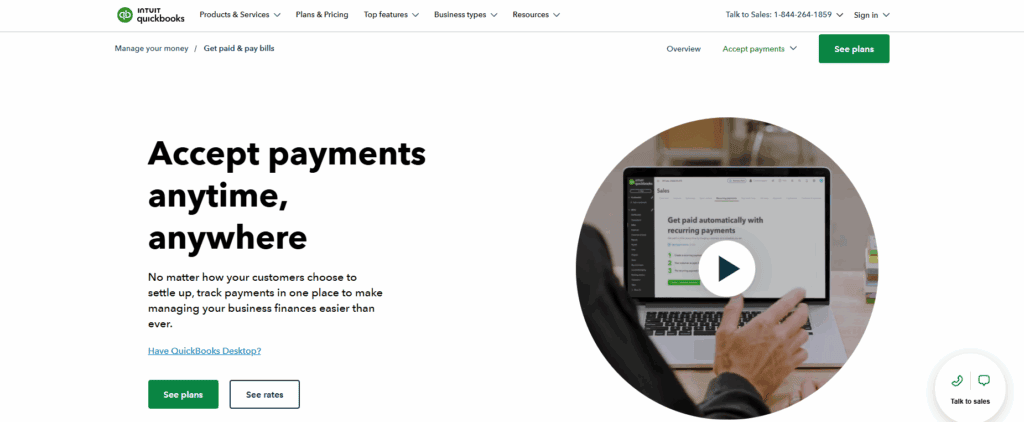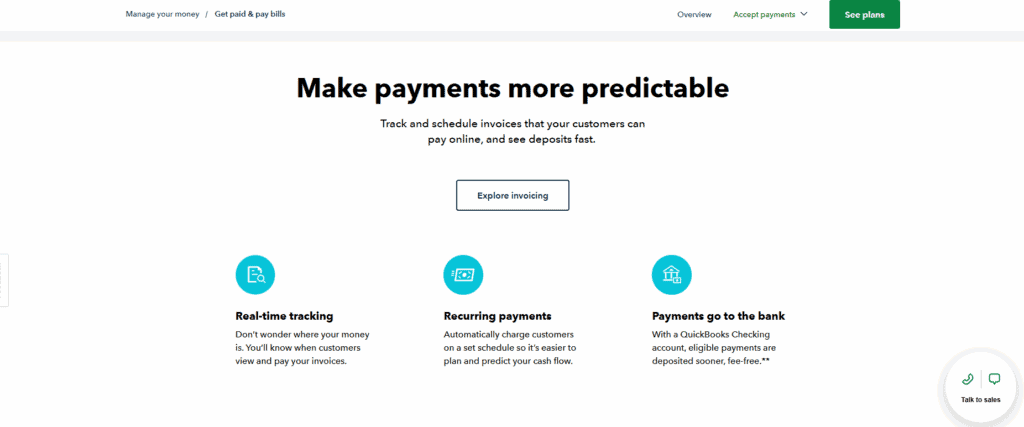Intuit QuickBooks Payments Review

Intuit QuickBooks Payments is a payment processing service built to work seamlessly with QuickBooks accounting software. Developed by Intuit, a trusted name in financial tools, this service enables small business owners to accept payments through credit cards, debit cards, ACH bank transfers, and mobile payment options. It’s particularly well-suited for those already using QuickBooks Online or Desktop, thanks to its native integration. Lets read more about Intuit QuickBooks Payments Review.
The core value lies in its simplicity. Once activated, users can send invoices with secure payment links, allowing clients to pay instantly. This direct connection between invoicing and payment collection speeds up cash flow and reduces the chances of data entry errors. Businesses can also automate parts of the reconciliation process.
However, when utilised within the QuickBooks ecosystem, its advantages become most noticeable. The advantages might seem limited if QuickBooks isn’t your current accounting program. Support for international transactions is weak, and there is little integration with other platforms. But QuickBooks Payments is a reliable option if you’re looking for a single accounting and payment system.
Getting Started and Onboarding Experience | Intuit QuickBooks Payments Review
QuickBooks Payments offers a quick and easy sign-up process, especially for users already on QuickBooks. You’ll need to provide standard business details like your company name, tax ID, bank account info, and contact data. In most cases, approval is fast, although some businesses may be asked for extra verification documents.
For QuickBooks Online users, the onboarding process is nearly effortless. You can enable payments right from the dashboard, and everything is integrated into the familiar QuickBooks interface. This consistency is a major plus for users who prefer not to juggle between multiple platforms. That said, if you’re not a current QuickBooks user, the setup may feel less intuitive. The features are tailored for users inside the QuickBooks ecosystem, and standalone functionality is limited. High-risk industries may also encounter more detailed underwriting processes or slower approval times.
Still, the onboarding experience earns high praise for its speed and ease; particularly for small and midsize businesses with basic payment needs.
Payment Methods and Supported Transactions
QuickBooks Payments supports a solid range of transaction types, giving customers flexibility in how they pay. The platform accepts all major debit and credit cards, including Visa, Mastercard, Discover, and American Express. ACH bank transfers are also supported, offering a lower-cost alternative for recurring or high-ticket payments. Invoices can be sent via email with a built-in “Pay Now” button, making it easy for customers to complete payments online. Businesses can also set up recurring billing or generate quick payment links for one-time transactions. This is ideal for businesses that collect deposits or partial payments.
QuickBooks provides a card reader and GoPayment mobile app for in-person transactions. This makes it possible for vendors, small merchants, and service providers to take payments while on the go with a mobile device. The absence of strong international support is one disadvantage. The absence of cross-border capabilities and multi-currency payments may be a barrier for companies with international operations. Even though they are less expensive, ACH payments settle more slowly than card transactions.
Overall, QuickBooks Payments covers the core payment methods most small businesses need and does so from a unified interface.
Integration with the QuickBooks Ecosystem
The biggest draw of QuickBooks Payments is how well it integrates with the wider QuickBooks suite. When a payment comes in, it’s automatically applied to the correct invoice, and your books are updated in real time. This kind of automation saves time and minimizes accounting errors. You can view payment statuses, track overdue invoices, and keep tabs on cash flow without leaving your accounting dashboard. During tax season, this integration is a major benefit. With categorized transactions and automated reporting, pulling financial reports becomes far less stressful.
You can also set rules for how payments should be recorded, adding a layer of customization. However, this tight link to QuickBooks comes with a downside. If you switch to another accounting platform later, moving data out of the system may be challenging. Businesses that rely on third-party accounting software will miss out on these integrated features. But for businesses already committed to QuickBooks, having payments, invoicing, and bookkeeping under one roof offers unbeatable convenience.
Pricing and Transaction Fees
QuickBooks Payments uses a transparent, pay-as-you-go pricing model. For online card payments, the typical rate is 2.9% + $0.25 per transaction. ACH bank transfers are more affordable, usually at a 1% flat fee, often with a maximum cap.
In-person card payments processed through GoPayment are a bit cheaper; around 2.4% + $0.25 per swipe. There are no monthly fees for the basic version, which makes it attractive to businesses with lower or irregular transaction volumes. Additional hardware or premium features may involve extra costs.
Although it’s not always the most affordable choice for high-volume retailers, QuickBooks Payments offers pricing comparable to rivals like Stripe or Square. Custom pricing options should be compared by businesses that handle a lot of payments. Additionally, keep in mind that chargebacks have costs and that processing fees are not reimbursed for transactions that are returned. Users have occasionally complained about minor updates or changes that aren’t clearly explained, even though Intuit is transparent about its pricing.
Invoicing, Estimates, and Customer Experience
QuickBooks Payments allows you to generate professional invoices directly within the platform. You can customize line items, tax rates, due dates, and even upload your business logo. These invoices are sent by email and include a direct payment link, making it easy for customers to pay via card or bank transfer. For recurring clients, invoices can be automated. You can also send reminders for overdue payments, reducing the time spent on manual follow-ups. Service providers and freelancers can take advantage of the estimates feature, which lets them send project quotes that can be converted into invoices later.
While customization is available, it’s not as deep as some standalone invoicing platforms. You can change colors, logos, and messages, but multilingual support and advanced formatting are limited. Still, the payment process for customers is smooth and hassle-free, which encourages quicker turnaround times on payments. For many small businesses, the level of customization and functionality is more than enough.
Reporting, Analytics, and Financial Insights
QuickBooks Payments includes basic but functional reporting tools. From the dashboard, users can view payment statuses, transaction histories, and upcoming deposits. Every payment is automatically linked to its corresponding invoice, so your records stay clean and accurate. You can also track metrics such as sales volume, outstanding invoices, and customer payment patterns. These insights help businesses stay on top of their cash flow and identify areas that may need attention.
Reports can be used when preparing taxes or exported for additional analysis. Additionally, users can easily access more comprehensive reports like balance sheets, tax summaries, and profit and loss statements because the tool is integrated into the QuickBooks ecosystem. However, there aren’t many features for detailed analytics or advanced financial forecasting. Additional tools may be required by businesses seeking long-term trends or in-depth data segmentation.
But for most small businesses, the included analytics offer just enough visibility to stay informed and make confident financial decisions.
Hardware and In-Person Payment Solutions
Though best known for online payments, QuickBooks Payments also supports in-person transactions through the GoPayment app. Paired with a mobile card reader, the app turns a smartphone or tablet into a payment terminal. The available hardware supports EMV chip cards, tap-to-pay options, and magstripe swipes. It connects via Bluetooth and is compact enough for on-the-go usage. This setup is ideal for pop-up vendors, contractors, or field service professionals who want to accept payments on-site.
Once a payment is processed, it syncs instantly with your accounting data, eliminating the need to manually update records. The GoPayment setup isn’t as robust as a full POS system. It lacks features like detailed inventory tracking, employee management, or loyalty programs. But for businesses with light in-person sales needs, it covers the essentials well.
Security, Compliance, and Customer Support
QuickBooks Payments takes security seriously. The system is PCI-compliant and uses strong encryption to protect payment data. Additional tools such as fraud monitoring, account alerts, and multi-factor authentication help further secure sensitive information. Team access can be restricted based on roles, allowing business owners to control who sees financial details. These measures help maintain trust with customers and ensure a safe transaction environment.
Support is offered via phone, live chat, and a comprehensive help centre with video tutorials and guides. Another useful tool for resolving typical problems is the QuickBooks community forums. The quality of customer service, however, can differ. During busy times, some users complain about lengthy wait times or trouble handling chargebacks. Others feel non-accountants cannot understand the documentation because it is too technical.
Even so, the platform provides solid security and enough support channels to address most concerns. Businesses with sensitive data can use it confidently, though patience may be needed during busy times.
Pros and Cons Summary
QuickBooks Payments offers strong value for businesses already using QuickBooks for their accounting. It simplifies invoicing, reporting, and reconciliation while allowing customers to pay in multiple ways. Its benefits include fast setup, integrated financial tools, and flexible payment methods. Service providers, freelancers, and small shops will find the platform especially convenient.
On the downside, limited international support, basic customization, and reliance on the QuickBooks ecosystem may deter some users. Also, while pricing is fair, it’s not the most cost-effective for high-volume merchants. Still, for small businesses seeking a streamlined, reliable, and integrated payment solution, QuickBooks Payments is a solid option.
FAQs
Q1. Can I use QuickBooks Payments without QuickBooks Online or Desktop?
QuickBooks Payments is built to work best with QuickBooks Online and Desktop. While limited usage without the accounting software is technically possible, the platform’s true advantages come from full integration.
Q2. How quickly are payments deposited into my account?
Credit card payments typically settle within 1 to 2 business days. ACH transfers may take up to 5 business days. Some users may qualify for next-day deposits, depending on account status.
Q3. Does QuickBooks Payments support international or multicurrency payments?
Currently, QuickBooks Payments only supports transactions in USD for U.S.-based businesses. It does not handle cross-border payments or multi-currency billing, which can be a limitation for international operations.








